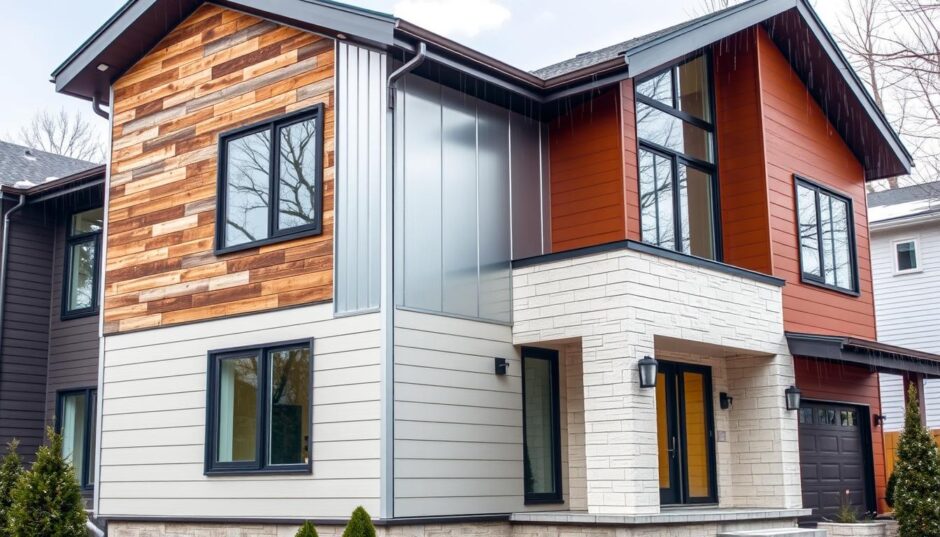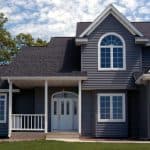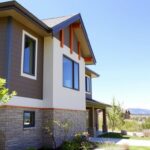Is Insulated Vinyl Siding Worth the Investment? Discover the Benefits and Costs
Are you considering upgrading your home’s exterior? Insulated vinyl siding may be the solution you’re looking for. In this article, we will explore whether insulated vinyl siding is worth the investment and discuss its benefits and costs.
Insulated vinyl siding is a popular choice among homeowners for several reasons. Firstly, it provides excellent insulation, helping to regulate your home’s temperature and reduce energy costs. With rising energy prices, this can be a significant advantage. Secondly, insulated vinyl siding is durable and low-maintenance, saving you time and money on repairs and upkeep. Finally, it offers a wide range of styles and colours, allowing you to customize your home’s appearance to suit your tastes.
Of course, all investments have their costs. In this article, we will also delve into the upfront and ongoing costs of insulated vinyl siding, ensuring you have all the necessary information to make an informed decision. Whether you’re looking to increase your home’s energy efficiency or enhance its curb appeal, join us as we explore the benefits and costs of insulated vinyl siding.
Benefits of Insulated Vinyl Siding
Insulated vinyl siding has gained immense popularity among homeowners for a myriad of reasons, but what makes it stand out among other siding options? One of the key benefits is its remarkable insulation properties. This type of siding features a rigid foam insulation layer that is attached to the back of the vinyl panels, creating an energy-efficient barrier that helps maintain consistent indoor temperatures. This insulation not only keeps homes warmer in winter but also cooler in summer, thereby reducing the reliance on heating and cooling systems.
In addition to improved thermal performance, insulated vinyl siding also contributes to a home’s overall energy efficiency. With the ever-increasing energy costs, homeowners are always on the lookout for ways to reduce their utility bills. Insulated vinyl siding acts as a thermal blanket, minimizing heat transfer and preventing drafts. This efficiency translates into significant savings over time, providing a return on investment that can be quite appealing. Homeowners can expect lower energy bills, which can add up to substantial savings year after year.
Moreover, insulated vinyl siding is also environmentally friendly. By reducing energy consumption, it lowers the carbon footprint of a home. Many manufacturers produce insulated vinyl siding from recycled materials, and the longevity of this product means less frequent replacements, contributing to reduced waste. Homeowners can feel good about their choice, knowing that they are making a positive impact on the environment while enjoying the benefits of energy efficiency.
Energy Efficiency and Cost Savings
The energy efficiency of insulated vinyl siding is one of its most compelling advantages. In a world where climate control can account for a significant portion of monthly expenses, investing in an energy-efficient siding solution can lead to considerable savings. Insulated vinyl siding is designed to hold in heat during the colder months and keep it out during warmer periods. This capability ensures that the heating and cooling systems don’t have to work overtime, leading to reduced energy consumption.
Homeowners who opt for insulated vinyl siding often report noticeable decreases in their utility bills. According to various studies, this siding can lower heating costs by up to 20 percent, depending on the climate and the home’s overall energy efficiency. While the initial investment in insulated siding may be higher than traditional siding options, the long-term savings on energy bills can offset this cost in just a few years. This makes it a financially sound decision for many homeowners.
Furthermore, many utility companies offer rebates or incentives for homeowners who invest in energy-efficient home improvements, including insulated vinyl siding. This means that the upfront costs can be mitigated further, making it an even more appealing investment. Homeowners can not only enjoy lower energy costs but may also benefit from financial incentives designed to encourage energy-efficient home renovations.
Durability and Low Maintenance
Durability is another hallmark of insulated vinyl siding. Unlike traditional wood siding, which can warp, rot, or suffer from insect damage, insulated vinyl siding is engineered to withstand the elements. It is resistant to moisture, which prevents mold and mildew growth, and it is also impervious to pests, ensuring that your home remains protected for years to come. This durability translates into fewer repairs and replacements over time, ultimately saving homeowners both time and money.
In addition to being durable, insulated vinyl siding requires minimal maintenance. A simple wash with soap and water is usually sufficient to keep it looking fresh and clean. Unlike painted surfaces that may need regular repainting, insulated vinyl siding retains its color and finish without the need for constant upkeep. This low-maintenance aspect is especially appealing to busy homeowners who may not have the time or inclination to perform frequent exterior maintenance tasks.
Moreover, many manufacturers offer warranties that can extend up to 30 years for insulated vinyl siding. This assurance of quality and longevity means that homeowners can invest with confidence, knowing that they are choosing a product designed to last. With such a long lifespan and minimal maintenance requirements, insulated vinyl siding can be a wise investment that pays off in terms of both performance and aesthetics.
Enhanced Curb Appeal and Aesthetics
Insulated vinyl siding is not only functional but also highly attractive. With a wide variety of styles, colors, and textures available, homeowners can customize the appearance of their homes to reflect their personal tastes and preferences. Whether you prefer the classic look of wood grain, the sleekness of contemporary designs, or a traditional smooth finish, insulated vinyl siding offers options that can enhance the curb appeal of any home.
In terms of aesthetics, insulated vinyl siding can significantly elevate the look of a property. Many homeowners find that by upgrading to this type of siding, their homes achieve a more polished and modern appearance. This can increase property value and appeal to potential buyers if the homeowner decides to sell in the future. First impressions matter, and a well-maintained exterior can make all the difference when it comes to curb appeal.
Additionally, insulated vinyl siding can mimic the look of more expensive materials such as stone or wood, allowing homeowners to achieve a high-end look without the associated costs and maintenance. This versatility in design means that insulated vinyl siding can suit any architectural style, providing an attractive and cohesive look to the home’s exterior.
Noise Reduction and Increased Comfort
Another often-overlooked benefit of insulated vinyl siding is its ability to reduce noise pollution, creating a more comfortable living environment. The insulation layer within the siding acts as a sound barrier, effectively dampening external noises such as traffic, neighbors, and other disruptive sounds. This is particularly beneficial for homes located in busy urban areas or near highways, where noise can be a constant concern.
Homeowners frequently report a noticeable decrease in noise levels after installing insulated vinyl siding. This added tranquility can enhance the overall quality of life within the home, making it a more peaceful sanctuary. The combination of reduced noise and improved insulation creates a living space that is comfortable year-round, regardless of the weather conditions outside.
Moreover, the increased comfort provided by insulated vinyl siding is not only limited to sound reduction. By maintaining consistent indoor temperatures, this siding can contribute to a more pleasant living environment. Homeowners can enjoy their spaces without the discomfort of drafts or extreme temperatures, further enhancing the overall quality of their living experience.
Comparing the Costs of Insulated Vinyl Siding vs. Traditional Siding Options
When evaluating whether insulated vinyl siding is worth the investment, it’s essential to compare its costs to those of traditional siding options. Traditional siding materials, such as wood, aluminum, or fiber cement, often come with lower initial costs but may require more frequent maintenance and repairs. Over time, these costs can add up significantly, making insulated vinyl siding a more cost-effective choice in the long run.
The initial installation costs of insulated vinyl siding can be higher than those of traditional options due to the additional insulation layer and advanced manufacturing processes. However, considering the energy efficiency, durability, and low maintenance of insulated vinyl siding, homeowners often find that the total cost of ownership is lower over time. The longevity of insulated vinyl siding also plays a critical role; while traditional materials may require replacement or extensive repairs sooner, insulated vinyl siding can last for decades with minimal upkeep.
Another factor to consider is the potential return on investment (ROI) when it comes to home value. Homes with insulated vinyl siding generally have a higher resale value compared to those with traditional siding options. This can be particularly important for homeowners looking to sell in the future. The combination of energy savings, reduced maintenance costs, and enhanced curb appeal makes insulated vinyl siding a wise investment for many homeowners.
Factors to Consider When Investing in Insulated Vinyl Siding
Before making the decision to invest in insulated vinyl siding, homeowners should consider several factors to ensure that they are making the right choice for their specific needs. One of the primary considerations is the climate. Insulated vinyl siding performs exceptionally well in a variety of climates, but homeowners should evaluate their local weather patterns to determine how much insulation they truly need. In colder climates, additional insulation may provide more significant energy savings, while in milder areas, standard insulated siding may suffice.
Another crucial aspect to consider is the quality of the siding being purchased. Not all insulated vinyl siding products are created equal, and it is essential to research different brands and materials. Homeowners should look for products with high R-values, which indicate better insulation properties, and should also check for warranties that guarantee the product’s performance and durability. Reading reviews and seeking recommendations from trusted sources can help homeowners identify reliable manufacturers.
Budget is another important factor when investing in insulated vinyl siding. While it can be more expensive upfront, homeowners need to evaluate their long-term financial goals and the potential savings on energy bills. Exploring financing options, such as loans or contractor financing, can also help make this investment more manageable. Understanding the total cost of ownership, including installation and maintenance, will aid homeowners in making a well-informed decision.
Choosing the Right Insulated Vinyl Siding for Your Home
Selecting the right insulated vinyl siding for your home involves several considerations that can impact both aesthetics and performance. One of the first steps is to determine the style and color that best fits your home’s architecture and personal taste. Options range from traditional clapboard styles to modern board-and-batten designs, with a variety of colors that can complement any exterior design. Samples and swatches can be helpful tools in visualizing how different styles and colors will look on your home.
Another critical consideration is the thickness and insulation value of the siding. Insulated vinyl siding comes in various thicknesses, which can impact its R-value and overall energy efficiency. Homeowners should consult with professionals to determine the best product for their climate and energy efficiency goals. Additionally, checking the product’s performance ratings, such as its resistance to wind and impact, is crucial for ensuring long-lasting durability.
Finally, working with a reputable contractor can make a significant difference in the quality of the installation. Proper installation is key to maximizing the benefits of insulated vinyl siding, and a skilled contractor will ensure that the siding is applied correctly. Homeowners should seek out contractors with experience in installing insulated vinyl siding and should request quotes and references before making a selection. This careful approach can help ensure a successful and satisfying investment.
Conclusion: Is Insulated Vinyl Siding Worth the Investment?
In conclusion, insulated vinyl siding presents a compelling case for homeowners looking to upgrade their home’s exterior. With its myriad benefits, including energy efficiency, durability, low maintenance, enhanced curb appeal, and noise reduction, it is a wise investment for many. While the upfront costs may be higher than traditional siding options, the long-term savings on energy bills, reduced maintenance expenses, and potential increase in home value can make it well worth the initial investment.
Moreover, the customization options available with insulated vinyl siding allow homeowners to achieve the desired look for their home while enjoying the practical benefits this siding offers. When considering the factors involved in the investment, including climate, product quality, and installation, homeowners can make informed decisions tailored to their specific needs.
Ultimately, the choice to invest in insulated vinyl siding can lead to a more comfortable, efficient, and attractive home. As energy prices continue to rise and the demand for sustainable building materials grows, insulated vinyl siding stands out as a solution that meets both aesthetic and functional needs. For those looking to enhance their home’s exterior, insulated vinyl siding may be just the investment they need to elevate their living environment.







